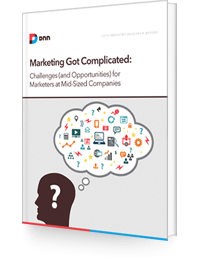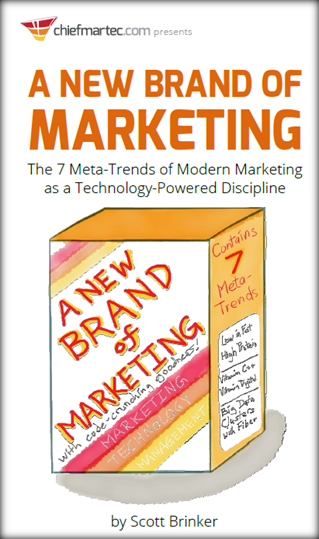
Sandra was a panelist on a recent DNN webinar, "Marketing Got Complicated: Challenges (and Opportunities) for Marketers at Mid-Sized Companies." During the webinar, Sandra provided endless wisdom for marketers at mid-sized companies. Following the webinar, she agreed to answer additional questions. Missed the webinar? Register to view the replay.
Everyone, Meet Sandra
Q: Tell
us about yourself, Sandra?
A: Professionally,
I am a technology marketer and have helped launch new businesses for large and
small companies. Today, I help companies put together agile marketing teams and
approaches to create speed, relevance and revenue. If you really want to know
more, here is some
deeper
insight about me as a person.
How to Reduce Marketing Complexity

Q: The
title of our report is “Marketing Got Complicated.” Do you agree?
A:
Completely and wholeheartedly.
In the tornado that is marketing today, it is
difficult to see a clear and straightforward way to map out your options and
then
focus and prioritize on the most
important areas, capabilities and investments.
The plethora of channels, communication overload, data-driven marketing
and iterative approaches all create a blur of possibilities that can take our
focus off of the customer and what is most important.
Taking smaller steps helps and creating a simpler approach is a
smart way to tackle the “marketing mountain” of options that are changing with
tremendous speed and magnitude.
“The
man who moves a mountain begins by carrying away small stones.” (Confucius)
How to Select Marketing Technology Solutions
Q: How
can marketers at mid-sized companies determine that they need to purchase a
particular marketing technology solution?
A: It’s
important to start with clear goals. What does the “home run” look like? For
starters, building marketing technology solutions on one platform so that you
can manage everything from one central place is extremely helpful.

Cobbling together pieces/parts after the fact is never fun. Also, it’s
important to find solutions that are “fit for use” versus ones that “boil the
ocean.”
My experience with a $1B company
revealed that our marketing automation platform was overly sophisticated for
our needs.
The way to ensure a good
match is to test drive before you buy.
In terms of approach, I like using a dual view. Using a top-down and
bottom-up approach can help match strategic needs of the business based on
customer needs (top-down) with the capabilities of tools in the marketplace
(bottom-up).
Chart: Sandra notes that cobbling together pieces and parts are not fun. Marketers at mid-sized companies tend to agree, as 69% find it "challenging to manage the growing number of technical vendors used by marketing."
Sizing Up Marketing at Mid-Sized Companies
Q: What’s
one thing marketers at mid-sized companies are doing well?
Mid-sized companies are
naturals
at being agile, which is a significant advantage that helps to level the
playing field with competitors who may have more marketing resources and
dollars. Using online tools such as
websites, social media and digital content are also inexpensive, low-entry-cost
approaches that mid-sized companies can easily leverage and be noticed, influential
and create impact.
Lastly, an advantage to a mid-size company is that – by nature of its
size – is often more “human” and emotionally savvy. This is the
foundation for being engaging and retaining loyal customers and
advocates.
Q: What’s
one thing marketers at mid-sized companies can do much better?
Leverage digital marketing to its fullest potential – as mentioned in
the question above – together with a
influencer and advocate marketing
outreach. These two tactics help to create significance and reach that is
much larger than the budget that funds them.

How to Engage Influencers on Twitter
By Dennis Shiao
Q: Name
a mid-sized company whose marketing you admire (and why)?
A: I’m
gong to cheat and name two.
The first: EKS&H is a company I have grown to admire. The CEO, Bob
Hottsman, sets the culture and tone of the business by focusing on his people. The
company consistently wins “best
places to work” awards and the employee rewards and recognition create a
level of loyalty and capability that is unrivaled. Further, the CEO is active
on many boards and does charity work to elevate the lives of children. He is a
role model because his behaviors tell you everything you need to know about
him. So admirable.
The second: CCAI is
Chinese Children
Adoption International. Josh and Lily are the founders and they are nothing
short of amazing in their quest to enrich the lives of orphaned children. With
limited budgets and resources, they are an adoption agency providing families
with thoughtful and supportive customer experiences at a reasonable price. Their
motto is the lower the cost, the more children we can place with families. They
utilize digital approaches and communities to help families navigate adoption.
Beautiful mission, elegantly implemented.
Recommended Reading for Marketers

Q: Tell
us about the most recent Marketing book that you’ve read?
A: I
just read a poignant and powerful e-book by Scott Brinker titled “A New
Brand of Marketing.” This book is elegantly simply written to hone in on
the core changes transforming marketing.Scott is “right on” with his discussion of the seven meta-trends that
have completely disrupted marketing.
Q: A
marketer at a mid-sized company tells you s/he can subscribe to just five blogs.
Tell us your five, along with the reason for your recommendation?

1)
Kare Anderson (@KareAnderson)
Her topic, “mutuality matters” is thoughtful, insightful and helpful. Using
collaboration and connectivity to create solutions with collective talents and
effort are the way to solve the world’s toughest challenges with warmth, shared
interests and mutual benefit.
2)
Copyblogger.
The writers of this blog are extraordinarily talented. The topics are
helpful for content creation and writing (something I strive to be better at)
and the content is delivered in the most engaging formats. Impressive.

3)
Michael Brenner (@BrennerMichael)
Michael is a smart marketer who stays very up-to-date on emerging trends
and has a way of explaining things simply and pragmatically. He is also
connected to many of my favorite thought leaders such as
Lee Odden, Joe
Pulizzi, Jay Baer, Jeffrey Rohrs, Jonathan Becher and others.

4)
Bryan Kramer (@bryankramer)
Bryan is a forward thinker and super creative. He just published
Human to Human and writes about leveraging a human approach in business regardless of
B2C or B2B.He is also connected with
some of my favorite content producers such as
Todd Wilms, Daniel Newman,
Jeremiah Owyang, DJ Waldow and others.

5)
Marc and Angel (@marcandangel)
This blog is inspirational, authentic and so well-written. I like this one to keep me centered,
connected and encouraged.
Work-Life Balance
Q: It
seems marketers at mid-sized companies are working constantly: office, home
office, coffee shop and more. How can they maintain a positive work/life
balance?
A: The
saying goes something like, “Do what you
love, and you’ll never work a day in your life.” This is mostly true. Life
is never balanced no matter your company size or job. Learning to embrace the
ebb and flow of life and deciding on your “must-haves” in each day are the best
pieces of advice I can provide. It reminds me of
the rock parable: know
what your big rocks are and start there.
The Future of Marketing
Q: What
does the future of Marketing hold?
A: A few
of the areas I think we will see in the future:
-
A renewed focus on customer engagement
- Using brand experience as a
differentiator
- Leveraging data-driven insights to cut
through the noise
- Broadening capabilities and
responsibilities in the marketing suite
- Real-time, agile and iterative
marketing approaches
I also think the street cred of marketers is increasingly exponentially.
More CMO’s are wanted on boards, we see
CMO’s
managing IT and CMO’s becoming CEO’s. Bravo!